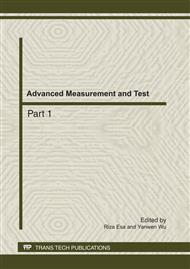[1]
Hauw JJ, Duyckaerts C, Delaere P, Lamy C, Henry P. Alzheimer's disease: neuropathological and etiological data. Biomed Pharmacother, (1989) , 43(7): p.469–482.
DOI: 10.1016/0753-3322(89)90107-8
Google Scholar
[2]
McKhann G, Drachman D, Folstein M, Katzman R, Price D, Stadlan EM. Clinical diagnosis of Alzheimer's disease: report of the NINCDS-ADRDA Work Group under the auspices of Department of Health and Human Services Task Force on Alzheimer's Disease. Neurology, (1984).
DOI: 10.1212/wnl.34.7.939
Google Scholar
[3]
Mendez MF. The accurate diagnosis of early-onset dementia. International Journal of Psychiatry Medicine, (2006) , 36 (4): p.401–412.
DOI: 10.2190/q6j4-r143-p630-kw41
Google Scholar
[4]
Klafki HW, Staufenbiel M, Kornhuber J, Wiltfang J. Therapeutic approaches to Alzheimer's disease. Brain, (2006) , 129 (Pt 11): p.2840–55.
DOI: 10.1093/brain/awl280
Google Scholar
[5]
Chetelat, G., Landeau, B., Eustache, F., Mezenge, F., Viader, F., de la Sayette, V., Desgranges, B., Baron, J.C., Using voxel-based morphometry to map the structural changes associated with rapid conversion in MCI: a longitudinal MRI study. Neuroimage, (2005).
DOI: 10.1016/j.neuroimage.2005.05.015
Google Scholar
[6]
Anne Hämäläinen, Susanna Tervo, Marta Grau-Olivares, et al., Voxel-based morphometry to detect brain atrophy in progressive mild cognitive impairment. NeuroImage, (2007) , 37: p.1122–1131.
DOI: 10.1016/j.neuroimage.2007.06.016
Google Scholar
[7]
Lehmann, M., et al., Cortical thickness and voxel-based morphometry in posterior cortical atrophy and typical Alzheimer's disease. Neurobiol. Aging, (2009).
Google Scholar
[8]
Claudia Plant, Stefan J. Teipel, Annahita Oswald, et at., Automated detection of brain atrophy patterns based on MRI for the prediction of Alzheimer's disease. NeuroImage, (2010) , 50: p.162–174.
DOI: 10.1016/j.neuroimage.2009.11.046
Google Scholar
[9]
Prashanthi Vemuri, Stephen D. Weigand, David S. Knopman, et al., Time-to-event voxel-based techniques to assess regional atrophy associated with MCI risk of progression to AD. NeuroImage, (2011) , 54: p.985–991.
DOI: 10.1016/j.neuroimage.2010.09.004
Google Scholar
[10]
Andrea Mechelli, Cathy J. Price, Karl J. Friston, John Ashburner, Voxel-Based Morphometry of the Human Brain: Methods and Applications. Current Medical Imaging Reviews, (2005), 1(1): pp.1-9.
DOI: 10.2174/1573405054038726
Google Scholar
[11]
Ashburner, J., A fast diffeomorphic image registration algorithm. NeuroImage, (2007) t. 1538 (1), p.95–113.
DOI: 10.1016/j.neuroimage.2007.07.007
Google Scholar
[12]
John AshburnerT , Karl J. Friston, Unified segmentation. NeuroImage, (2005) , 26: p.839– 851.
Google Scholar
[13]
G. McKhann, D. Drachmann, M. Foldstein, R. Katzman, D. Price, Clinical diagnosis of Alzheimer's disease: report of the NINCDS-ADRDA Work Group under auspices of Department of Health and Human Services Task Force of Alzheimer's Disease. Neurology 34 (1984).
DOI: 10.1212/wnl.34.7.939
Google Scholar
[14]
Duncan, J., Seitz, R.J., Kolodny, J., Bor, D., Herzog, H., Ahmed, A., Newell, F.N., Emslie, H., A neural basis for General Intelligence. Science, (2000), 289 (5478): p.457–460.
DOI: 10.1126/science.289.5478.457
Google Scholar
[15]
Ged Ridgway, Voxel-Based Morphometry with Unified Segmentation. Course from http: /www. cs. ucl. ac. uk/staff/G. Ridgway/zurich.
Google Scholar


